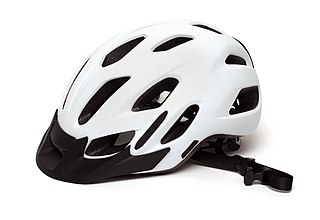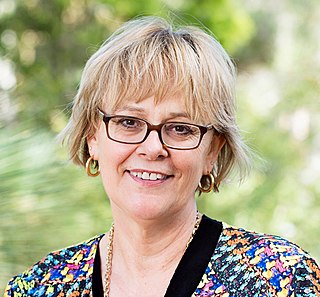
Snowboarding is a recreational and competitive activity that involves descending a snow-covered surface while standing on a snowboard that is almost always attached to a rider's feet. It features in the Winter Olympic Games and Winter Paralympic Games.

Alpine skiing, or downhill skiing, is the pastime of sliding down snow-covered slopes on skis with fixed-heel bindings, unlike other types of skiing, which use skis with free-heel bindings. Whether for recreation or for sport, it is typically practiced at ski resorts, which provide such services as ski lifts, artificial snow making, snow grooming, restaurants, and ski patrol.

Equestrianism, commonly known as horse riding or horseback riding, includes the disciplines of riding, driving, and vaulting. This broad description includes the use of horses for practical working purposes, transportation, recreational activities, artistic or cultural exercises, and competitive sport.

A concussion, also known as a mild traumatic brain injury (mTBI), is a head injury that temporarily affects brain functioning. Symptoms may include loss of consciousness; memory loss; headaches; difficulty with thinking, concentration, or balance; nausea; blurred vision; dizziness; sleep disturbances, and mood changes. Any of these symptoms may begin immediately, or appear days after the injury. Concussion should be suspected if a person indirectly or directly hits their head and experiences any of the symptoms of concussion. Symptoms of a concussion may be delayed by 1–2 days after the accident. It is not unusual for symptoms to last 2 weeks in adults and 4 weeks in children. Fewer than 10% of sports-related concussions among children are associated with loss of consciousness.

A bicycle helmet is a type of helmet designed to attenuate impacts to the head of a cyclist in collisions while minimizing side effects such as interference with peripheral vision.

Risk compensation is a theory which suggests that people typically adjust their behavior in response to perceived levels of risk, becoming more careful where they sense greater risk and less careful if they feel more protected. Although usually small in comparison to the fundamental benefits of safety interventions, it may result in a lower net benefit than expected or even higher risks.
Closed-head injury is a type of traumatic brain injury in which the skull and dura mater remain intact. Closed-head injuries are the leading cause of death in children under 4 years old and the most common cause of physical disability and cognitive impairment in young people. Overall, closed-head injuries and other forms of mild traumatic brain injury account for about 75% of the estimated 1.7 million brain injuries that occur annually in the United States. Brain injuries such as closed-head injuries may result in lifelong physical, cognitive, or psychological impairment and, thus, are of utmost concern with regards to public health.

The Snell Memorial Foundation is a nonprofit organization created to provide a high quality standard of safety for helmets. Founded in 1957, the foundation is named after William "Pete" Snell, a popular sports car racer who died in 1956 of head injuries he received when the racing helmet he wore failed to protect his head. A group of friends, scientists, physicians, and others joined together to create a group that would promote research and education as well as test and develop standards to improve the effectiveness of helmets.
SafetyLit is a bibliographic database and online update of recently published scholarly research of relevance to those interested in the broad field of injury prevention and safety promotion. Initiated in 1995, SafetyLit is a project of the SafetyLit Foundation in cooperation with the San Diego State University College of Health & Human Services and the World Health Organization - Department of Violence and Injury Prevention.

Backcountry snowboarding is snowboarding in a sparsely inhabited rural region over ungroomed and unmarked slopes or pistes in the backcountry, frequently amongst trees, usually in pursuit of fresh fallen snow, known as powder. Often, the land and the snow pack are not monitored, patrolled, or maintained. Fixed mechanical means of ascent such as ski lifts are typically not present, but alternative means such as splitboarding, hiking, snowshoeing and helicopters ("heliskiing") are sometimes used to reach the mountain's peak.

Some countries and lower jurisdictions have enacted laws or regulations which require cyclists to wear a helmet in certain circumstances, typically when riding on the road or a road-related area. In some places this requirement applies only to children under a certain age, while in others it applies to cyclists of all ages.

Prevention of mild traumatic brain injury involves taking general measures to prevent traumatic brain injury, such as wearing seat belts, using airbags in cars, securing heavy furnitures and objects before earthquake or covering and holding under the table during an earthquake. Older people are encouraged to try to prevent falls, for example by keeping floors free of clutter and wearing thin, flat, shoes with hard soles that do not interfere with balance.
Concussions, a type of mild traumatic brain injury, are a frequent concern for those playing sports, from children and teenagers to professional athletes. Repeated concussions are known to cause neurological disorders, particularly chronic traumatic encephalopathy (CTE), which in professional athletes has led to premature retirement, erratic behavior and even suicide. A sports-related concussion is defined as a "complex pathophysiological process affecting the brain, induced by biomechanical forces". Because concussions cannot be seen on X-rays or CT scans, attempts to prevent concussions have been difficult.

Half-pipe skiing is the sport of riding snow skis on a half-pipe. Competitors perform a series of tricks while going down the pipe. The current world record for highest jump in a half-pipe is held by Joffrey Pollet-Villard, with 26 feet 3 inches. The sport is considered to be dangerous compared to other sports, and helmets are required to be worn during competitions. Half-pipe skiing has been part of the Winter X Games since 2002, and made its Olympic debut at the 2014 Winter Olympics in Sochi, Russia. David Wise of the United States of America became the first Olympic champion in this discipline with a total of 92.00 points.
A catastrophic injury is a severe injury to the spine, spinal cord, or brain. It may also include skull or spinal fractures. This is a subset of the definition for the legal term catastrophic injury, which is based on the definition used by the American Medical Association.
A traumatic brain injury (TBI) is a blow, jolt or penetration to the head that disrupts the function of the brain. Most TBIs are caused by falls, jumps, motor vehicle traffic crashes, being struck by a person or a blunt object, and assault. Student-athletes may be put at risk in school sports, creating concern about concussions and brain injury. A concussion can be caused by a direct blow to the head, or an indirect blow to the body that causes reactions in the brain. The result of a concussion is neurological impairment that may resolve spontaneously but may also have long-term consequences.
Winter X Games XIX were held from January 21 to January 25, 2015, in Aspen, Colorado. They were the 14th consecutive Winter X Games to be held in Aspen. The events were broadcast on ESPN. The games featured participants from the United States, Canada, Norway, Sweden, Japan, New Zealand, France, Switzerland, Italy, and Australia.
Shred Optics is a manufacturer of sunglasses, helmets and goggles designed for skiing, mountain biking, snowboarding and other forms of outdoor recreation. The company is based in Park City, Utah, and Venice, Italy.

Caroline Finch AO is an Australian sports injury epidemiologist and sports injury prevention researcher. Her research has been adopted and used to directly inform safety policy by Government Departments of Sport and Health, health promotion and injury prevention agencies, and peak sports bodies both within Australia and internationally. Her injury prevention research has been applied to falls in older people, road safety, workplace safety and injuries in children.
This glossary of skiing and snowboarding terms is a list of definitions of terms and jargon used in skiing, snowboarding, and related winter sports.












